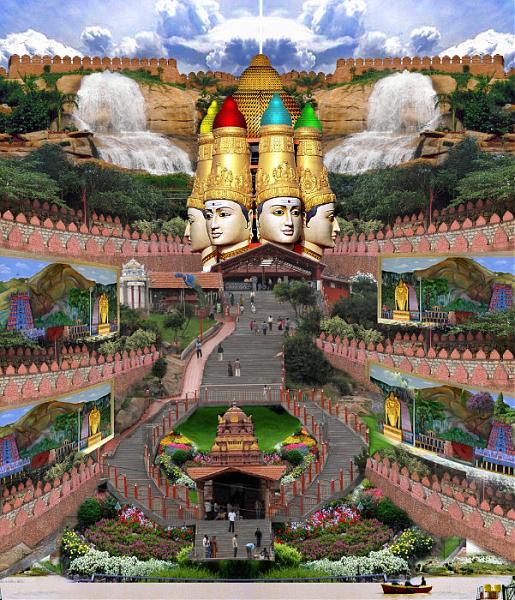
Shanmukha Temple in Rajarajeswari Nagar, Bangalore
பாரப்பா அறுபத்து நான்கு யோகம்
பார்த்திலே வீணாக வளைந்து பார்த்து
ஆரப்பா ராசாங்க யோகந்தன்னை
அறியாமல் அலைந்தவர்கள் அனந்தங்கோடி
நேரப்பா நின்ற நிலை கண்டு மைந்தா
நினைவிருத்தித் தவசு பண்ணி நிலையைப் பார்த்து
வேறப்பா எழுத்துக்களைச் சேர்த்துச் சேர்த்து
விண்ணென்று மண்ணென்று மறந்திடாயே
Translation:
See son, the sixtyfour yoga
Looking at it in a crooked fashion
Who will see the Rajaanga yoga
Those who roamed around without knowing it are several crores
See the state correctly
Holding the thought, performing the austerities, seeing the status
Joining the letters, one with the other,
Do not forget they are the sky and the earth.
Commentary:
Subramanyar is talking to Agatthiyar about a very important concept in this verse. He is explaining the breathing practice which is the basis for raja yoga. Agatthiyar has explained it further in his Saumya sagaram verse 287. Our breathing consists of the three parts inhalation, exhalation and retention. If these three steps are carried out in measured fashion it is called pranayama. Agatthiyar mentions in his verse that the inhalation should be carried out for 32 measures of time it is retained for 64 measures of time and exhaled for 16 measures of time. This pattern of breathing activates the fire of kundalini in our body. When the fire rises in our body the distinctions merge with one another. These principles are represented by various Sanskrit letters. To indicate this merging Subramanyar is telling Agatthiyar that these letters are joined with one another. The sky represents the state of complete merging and the earth represents the state of complete distinction.
இப்பாடலில் சுப்பிரமணியர் ஒரு முக்கியமான விஷயத்தைப் பேசுகிறார். அது ராசயோகத்தின் அடிப்படையாக இருக்கும் பிராணாயாமத்தைப் பற்றியது. பொதுவாக நமது சுவாசம் பூரகம் அல்லது உள்மூச்சு, ரேசகம் அல்லது வெளி மூச்சு மற்றும் கும்பகம் அல்லது உள்ளே இருத்துதல் என்ற மூன்று பகுதிகளைக் கொண்டது. இந்த மூன்று பகுதிகளும் ஒரு குறிப்பிட்ட கால அளவு மேற்கொள்ளப்பட்டால் அதுவே பிராணாயாமம் எனப்படும். அகத்தியர் தனது சௌமிய சாகரத்தில் இந்த மூன்று பகுதிகளும் எவ்வளவு கால அளவு மேற்கொள்ளப்படவேண்டும் என்று கூறுகிறார். பூரகம் 32 மாத்திரை அளவும், கும்பகம் 64 கால அளவும் ரேசகம் 16 கால அளவும் மேற்கொள்ளப்பட வேண்டும் என்கிறார் அவர். இந்த பிராணாயாம முறை உடலில் உள்ள குண்டலினி அக்னியை விழித்தெழச் செய்கிறது. இதைத்தான் சுப்பிரமணியர் 64 யோகம் என்கிறார். ஏனெனில் கும்பகம் உடலில் உள்ள குண்டலினி அக்னியை விழித்தெழச் செய்கிறது. இவ்வாறு தனது விழிப்புணர்வை விழித்தெழச் செய்யும் யோகி தத்துவங்களின் தனிப்பட்ட நிலையைக் கடந்து ஒருமை நிலையை அடைகிறார். இந்த தத்துவங்கள் ஒவ்வொன்றும் ஒரு குறிப்பிட்ட எழுத்தால் காட்டப்படுகிறது. இவ்வாறு லயம் அல்லது ஒருமை நிலை என்பது இந்த எழுத்துக்களை ஒன்றுடன் ஒன்றைச் சேர்ப்பதாகிறது. இந்த லய நிலையை சுப்பிரமணியர் வானம் என்றும் தத்துவங்களின் தனிப்பட்ட நிலையை பூமி என்றும் அவர் குறிக்கிறார்.
பார்த்திலே வீணாக வளைந்து பார்த்து
ஆரப்பா ராசாங்க யோகந்தன்னை
அறியாமல் அலைந்தவர்கள் அனந்தங்கோடி
நேரப்பா நின்ற நிலை கண்டு மைந்தா
நினைவிருத்தித் தவசு பண்ணி நிலையைப் பார்த்து
வேறப்பா எழுத்துக்களைச் சேர்த்துச் சேர்த்து
விண்ணென்று மண்ணென்று மறந்திடாயே
Translation:
See son, the sixtyfour yoga
Looking at it in a crooked fashion
Who will see the Rajaanga yoga
Those who roamed around without knowing it are several crores
See the state correctly
Holding the thought, performing the austerities, seeing the status
Joining the letters, one with the other,
Do not forget they are the sky and the earth.
Commentary:
Subramanyar is talking to Agatthiyar about a very important concept in this verse. He is explaining the breathing practice which is the basis for raja yoga. Agatthiyar has explained it further in his Saumya sagaram verse 287. Our breathing consists of the three parts inhalation, exhalation and retention. If these three steps are carried out in measured fashion it is called pranayama. Agatthiyar mentions in his verse that the inhalation should be carried out for 32 measures of time it is retained for 64 measures of time and exhaled for 16 measures of time. This pattern of breathing activates the fire of kundalini in our body. When the fire rises in our body the distinctions merge with one another. These principles are represented by various Sanskrit letters. To indicate this merging Subramanyar is telling Agatthiyar that these letters are joined with one another. The sky represents the state of complete merging and the earth represents the state of complete distinction.
இப்பாடலில் சுப்பிரமணியர் ஒரு முக்கியமான விஷயத்தைப் பேசுகிறார். அது ராசயோகத்தின் அடிப்படையாக இருக்கும் பிராணாயாமத்தைப் பற்றியது. பொதுவாக நமது சுவாசம் பூரகம் அல்லது உள்மூச்சு, ரேசகம் அல்லது வெளி மூச்சு மற்றும் கும்பகம் அல்லது உள்ளே இருத்துதல் என்ற மூன்று பகுதிகளைக் கொண்டது. இந்த மூன்று பகுதிகளும் ஒரு குறிப்பிட்ட கால அளவு மேற்கொள்ளப்பட்டால் அதுவே பிராணாயாமம் எனப்படும். அகத்தியர் தனது சௌமிய சாகரத்தில் இந்த மூன்று பகுதிகளும் எவ்வளவு கால அளவு மேற்கொள்ளப்படவேண்டும் என்று கூறுகிறார். பூரகம் 32 மாத்திரை அளவும், கும்பகம் 64 கால அளவும் ரேசகம் 16 கால அளவும் மேற்கொள்ளப்பட வேண்டும் என்கிறார் அவர். இந்த பிராணாயாம முறை உடலில் உள்ள குண்டலினி அக்னியை விழித்தெழச் செய்கிறது. இதைத்தான் சுப்பிரமணியர் 64 யோகம் என்கிறார். ஏனெனில் கும்பகம் உடலில் உள்ள குண்டலினி அக்னியை விழித்தெழச் செய்கிறது. இவ்வாறு தனது விழிப்புணர்வை விழித்தெழச் செய்யும் யோகி தத்துவங்களின் தனிப்பட்ட நிலையைக் கடந்து ஒருமை நிலையை அடைகிறார். இந்த தத்துவங்கள் ஒவ்வொன்றும் ஒரு குறிப்பிட்ட எழுத்தால் காட்டப்படுகிறது. இவ்வாறு லயம் அல்லது ஒருமை நிலை என்பது இந்த எழுத்துக்களை ஒன்றுடன் ஒன்றைச் சேர்ப்பதாகிறது. இந்த லய நிலையை சுப்பிரமணியர் வானம் என்றும் தத்துவங்களின் தனிப்பட்ட நிலையை பூமி என்றும் அவர் குறிக்கிறார்.
Awesome Explanation..
ReplyDeleteVel vel Muruga, Vetri Vel Muruga!
ReplyDeleteFor those who wish to know more about this concept please refer to Sivavakkiyam verse beginning சங்கிரண்டு தாரை ஒன்று சன்ன பின்னல் ஆகையால் and Agatthiyar's verse பன்னிரண்டுகால் புரவியப்பா
ReplyDeleteA request to the readers
ReplyDeleteThis is a blog for discovery and understanding of the supreme truths revealed by the Siddhas though mutual sharing and discussions. This is not a site for showcasing anyone's expertise in the Tamil Siddha philosophy or yoga. The bloggers are amateur translators, commentators who wish to humbly share the knowledge they received from several of their teachers and gurus. The goal of this blog is to bring the siddha poetry and philosophy that were held as personal property by some, to the public view. Hence, kindly refrain from personal attacks or mudslinging as this is not the appropriate forum for it. Having said that, the bloggers always welcome any comments or clarifications that would help a greater community to appreciate the Siddha poetry and philosophy.